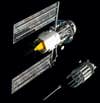This technology is very far out–in miles and years. A pair of satellites orbiting several hundred miles above the Earth would serve as a weapons system. One functions as the targeting and communications platform while the other carries numerous tungsten rods–up to 20 feet in length and a foot in diameter–that it can drop on targets with less than 15 minutes’ notice. When instructed from the ground, the targeting satellite commands its partner to drop one of its darts. The guided rods enter the atmosphere, protected by a thermal coating, traveling at 36,000 feet per second–comparable to the speed of a meteor. The result: complete devastation of the target, even if it’s buried deep underground. (The two-platform configuration permits the weapon to be “reloaded” by just launching a new set of rods, rather than replacing the entire system.)
The concept of kinetic-energy weapons has been around ever since the RAND Corporation proposed placing rods on the tips of ICBMs in the 1950s; the satellite twist was popularized by sci-fi writer Jerry Pournelle. Though the Pentagon won’t say how far along the research is, or even confirm that any efforts are underway, the concept persists. The “U.S. Air Force Transformation Flight Plan,” published by the Air Force in November 2003, references “hypervelocity rod bundles” in its outline of future space-based weapons, and in 2002, another report from RAND, “Space Weapons, Earth Wars,” dedicated entire sections to the technology’s usefulness.
If so-called “Rods from God”–an informal nickname of untraceable origin–ever do materialize, it won’t be for at least 15 years. Launching heavy tungsten rods into space will require substantially cheaper rocket technology than we have today. But there are numerous other obstacles to making such a system work. Pike, of GlobalSecurity.org, argues that the rods’ speed would be so high that they would vaporize on impact, before the rods could penetrate the surface. Furthermore, the “absentee ratio”–the fact that orbiting satellites circle the Earth every 100 minutes and so at any given time might be far from the desired target–would be prohibitive. A better solution, Pike argues, is to pursue the original concept: Place the rods atop intercontinental ballistic missiles, which would slow down enough during the downward part of their trajectory to avoid vaporizing on impact. ICBMs would also be less expensive and, since they’re stationed on Earth, would take less time to reach their targets. “The space-basing people seem to understand the downside of space weapons,” Pike says–among them, high costs and the difficulty of maintaining weapon platforms in orbit. “But I’ll still bet you there’s a lot of classified work on this going on right now.”
The Rods are just one of the world’s spookiest weapons. Launch the entire gallery of terrifying weapons here.
The Atomic Bomb
The first weapon on the list is arguably both the spookiest and the most terrifying from beginning to end. Whether you side with those who say its use in WWII prevented an invasion of Japan and casualties on a much larger scale, or those who denounce its use as a war crime, it is arguably the only weapon whose effects have so vividly solidified in the popular consciousness after such little use (twice). The bomb’s devastating reach extended well beyond the immediate blast radii; nearly half of the total number who died in 1945 as a direct resulting of the bombings in Hiroshima and Nagaski died from burns, radiation poisoning, and cancers.
Project X-Ray
In the early years of American involvement in WWII, a plan was conceived by a Pennsylvanian dental surgeon to strap tiny incendiary devices to bats and drop them by the thousands over Japanese cities. The bats—able to carry nearly three times their own body weight—would fly under the cover of night and take roost in traditional, highly-flammable wood and paper Japanese houses. As dawn approached, timers on the devices would ignite the “bat bombs” and entire cities would burn to the ground without the loss of life accompanied by, say, an atomic attack. The project was slowed by many complications and was ultimately shut down in 1944 because the bats would not be ready for combat until 1945.
MK-ULTRA
Begun in the 1950s by the CIA as a response to Korean techniques used on American POWs during the Korean War, MK-ULTRA became the code name for an extensive and covert program investigating the possibilities of mind-control through psychotropic and other mood-altering drugs. It was most notorious for dosing unwitting subjects with LSD [left] and following their behavior while under its influence. Another experiment involved injecting barbiturates followed by amphetamines, causing the subject to doze off and then be shocked awake into a trance-like state during which questioning would result in animated responses. In 1973, Richard Helms, CIA Director at the time, ordered all MK-ULTRA files destroyed, which effectively curtailed any meaningful investigation the Congress attempted to pursue two years later, in 1975.
The Stargate Project
We move from spooky to kooky with an operation begun under the Army’s military intelligence in the 1970s called the Stargate Project. While its aims may have had a scientific underpinning—it was an attempt to bring quantifiable measurements to clairvoyance—it was largely a last ditch effort to generate intelligence about a situation when there was no other avenue to pursue. The project used a small group of “remote viewers” who were people claiming to possess a variety of extra sensory abilities, from reading tarot cards to predicting the future, to divining the nature of covered or hidden objects in aerial photographs. While the results of any given viewing were kept highly secret so as not to damage the confidence of the clairvoyants, we can likely conclude the outcomes were not terribly accurate, as in 1995 the project was transferred to and subsequently shut down by the CIA.
The CornerShot
William Prescott readied his men at the Battle of Bunker Hill with the now famous words, “do not fire until you see the whites of their eyes!” Fortunately, his men were fighting in the American Revolution and not on the modern battlefield against the CornerShot, a weapon designed specifically so that the enemy will never see your eyes. A miniature camera and LCD screen sub in for the gunner’s “eyes” as the front half of the rifle bends around corners in order to shoot targets without the operator having to come into the open. It works by mounting a semi-automatic pistol to the hinged front half with remote linkage to the trigger at the rear and can swivel through a 120-degree range.
Cetacean Intelligence Mission
The Navy has been training bottlenose dolphins since at least the late 1980s to patrol and protect warships, hunt for mines, and even to carry darts and target divers for attack. Once word of the program got out, animal rights activists raised public awareness causing the Navy to turn the details highly classified; today, little is known about the extent of the operations. We do know that the animals were fitted with electronic harnesses, which ostensibly relayed signal commands, and that they were trained to recognize divers in wetsuits like prowlers in the night. How the mechanism of firing the darts was accomplished is anyone’s guess.
The Gay Bomb
We return to the subject of spooky bombs with a device that never got any further than a three-page report [excerpt at left]. In the document, issued by a U.S. Air Force research laboratory in Ohio in 1994, the proposal was to develop a variety of bombs of uncommon ordinance (at a cost of $7.5 million), including: a flatulence bomb, which would stink so badly as to drive the enemy out of its hiding places; a bomb which would make the enemy sweat profusely; and a “halitosis bomb,” which would plague soldiers with bad breath. But the coup de grâce was the bomb now colloquially referred to as the “gay bomb.” Using a hypothetical aphrodisiac of remarkable potency, the bomb would spray the enemy with a substance that would quite literally turn them gay, causing the soldiers to become “irresistibly attracted to one another” and, we can only assume, forget that they were in the process of being bombed.
The Trophy Active Defense System
Tanks are frightening machines on their own without any need for upping the scare ante. So what could make these already heavily armored vehicles any more unstoppable? An invisible force field. Fine, so the Trophy Active Defense System isn’t literally a force field, but it’s as close as any countermeasure has yet come. Using a highly sophisticated network of radar units placed around the tank, the ADS can detect rocket propelled grenades and other low-tech munitions in time to target them and return pinpointed fire, destroying the munitions in mid-air. The ADS is capable of tracking multiple targets in nearly any direction, rendering tanks with the equipment nearly bulletproof.
Metal Storm
Metal Storm is an Australian-based company that has been developing a line of weapons which use stacked projectiles. Stacked projectile weapons are different from traditional guns in that they have no moving parts. Instead of loading a bullet into a chamber and having a mechanism such as a hammer initiate its firing, the Metal Storm weapons use electronics to manage the firing sequence. Bullets are tightly lined up within the gun and each is packed between an explosive propellant; the result of which is a weapon that can fire at a much higher rate than a traditional automatic. One bullet enters the barrel before the last has left, which creates a torrent of ammunition with firepower not unlike a high-powered, comic book-style laser.
Cyborg Moths
As if most people weren’t already creeped out enough by insects, the Defense Advanced Research Projects Agency (Darpa) has been working to develop cyborg spy moths. Darpa, the research arm of the Department of Defense, has already successfully implanted chips in cockroaches and rats, allowing humans to “drive” the animals with joysticks. In the case of the moths, the chip will be implanted at the pupal stage so that the animal grows around it and develops a “reliable tissue-machine interface.” The spy moth will then be released at the front lines and remotely piloted into enemy territory, potentially beaming back video and audio feeds along the way.
The Navy’s Railgun
The Navy is exploring the possibilities of trading the explosive energy of conventional warheads for kinetic energy using simple projectiles. On its face, it sounds like a step backward. But when you see the prototype railgun in action, firing a seven pound shell at seven times the speed of sound, you start to understand the power generated by tremendous acceleration: That non-explosive hunk of metal carries as much destructive force as a Tomahawk missile. The railgun works by storing a massive amount of electricity—the Navy is aiming for a 64 megajoule model—that is then sent through parallel rails. The current generates a strong magnetic field which then accelerates the projectile to mind-bending speeds. With the finished product, a 5-meter target can be hit from 200 nautical miles away.
The Puke Flashlight
No, it’s not a rave toy gone horribly wrong, it’s another spooky tool making its way into the hands of law enforcement and the military. Designed as one of a growing body of non-lethal incapacitating devices, the flashlight uses ultra bright, rapidly pulsating LEDs to first temporarily blind and then induce nausea and sometimes vomiting. The pulses quickly change color and duration, which can cause psychophysical effects in many people (although to what extent varies significantly). The same effect is sometimes inadvertently seen by helicopter pilots when sunlight rapidly flashes through their rotors, disorienting them in mid-flight. The flashlight has obvious downsides—the victim must be in front of the light and must not think quickly enough to look away—but is a promising tool for non-violent enforcement.
Mobility Denial System
We now move from the spooky into the somewhat goofy with the Marine’s Mobility Denial System; a fancy name for what is essentially cartoon slime. It’s actually less Inspector Gadget and more a potentially effective and valuable idea. It works like this: two polymers are mixed together—a liquid and a powder—to make a slurry, which is then pumped into a nozzle where it meets a stream of water. On contact with the water, the slurry turns into a viscous, sticky, and slippery gel, which can be sprayed on nearly any surface. It remains gooey for many hours, and when it dries can be swept away or reactivated with more water. It’s target uses are in crowd control and protecting building entrances or checkpoints. The only real danger comes from slips and falls; people reportedly have less control on the slime than they do on ice.
A Military-Grade Stink Bomb
The Air Force lab responsible for the gay bomb and the fart bomb have nothing on what the DOD has in the works today. Researchers at the Monell Chemical Senses Center in Philadelphia are working with the Department of Defense to develop the baddest smell you ever smelled. We’re talking a mixture of vomit, excrement, B.O., burnt hair, and rotting flesh and garbage. Just thinking about it is making me queasy. The important thing to note is the need for a combination of many sources of stench—just vomit or just burnt hair won’t do it because our brains can too readily adjust to accommodating one stink. But throw a half dozen at us and we’re at the mercy of our gag reflex. Ultimately, the potent cocktail could be used in a “bomb” of sorts for crowd dispersal. It’s also being considered for helping soldiers become accustomed to unpleasant environments.
The Scream
The Israeli Army has developed a device they’re calling “The Scream,” which issues short bursts of highly tuned sound designed to get in someone’s head and stay there most uncomfortably until they leave the device’s range. The noise isn’t particularly loud and the effect is nothing like standing too close to the speakers at a rock show. Instead, it’s tuned to a specific frequency that targets the inner ear and disrupts a person’s equilibrium. The result is nausea and dizziness even after the sound is no longer broadcast. It is an unbearable sensation, and covering your ears is no defense.
Active Denial System
The U.S. Air Force has borrowed a page out of the Marine’s naming conventions book (see: Mobility Denial System) with a device more commonly known as the “heat ray.” The heat ray looks like a nondescript satellite dish, mounted on the back of a military-grade news truck. But instead of gathering and focusing radio waves coming in, the weapon focuses millimeter waves (similar to microwaves, but shorter) and sends them out. The effect of those waves against human skin produces a sensation of intense burning which people are reportedly only able to stand for a few seconds. The military claims the waves penetrate the skin by only one sixty-fourth of an inch and cause no lasting damage, but the system is still in the early stages and is as yet unproven in the field.
The Rods from God
This one would be the hands down winner for spookiest name if the award weren’t just a consolation prize—the Rods from God will do just fine competing for the spookiest weapon, regardless of name, thank you very much. They are a kinetic energy device like the railgun, but instead of using electricity to achieve destructive velocities, they use gravity. The still-hypothetical system would be comprised of two satellites in orbit around the Earth. One would house the communications and targeting hardware, while the other would house the rods themselves, each up to a foot in diameter and twenty feet long. To fire, they would simply be released and allowed to fall back to Earth (with a bit of remote guidance). By the time they reached the surface, they’d be traveling at a speed of 36,000 feet per second and carry the destructive force of a nuclear warhead, only with none of the radioactive fallout.
Modular Disc-Wing Urban Cruise Munition
Again, we’re fans of the colloquial name: robotic frisbees of death. Currently in development under the auspices of the Air Force, the frisbees of death are robotic drones in the shape of flying discs and are designed for short flights into difficult to reach areas, like the upper stories of tall buildings or behind unnavigable obstacles. Sent airborne from a modified skeet launcher, the drones can either fly automatically or be piloted remotely from the ground. They’ll be packed with armor-piercing explosives and can be set to detonate all at once or to disperse their payload over a range.
Airborne Laser
While the Pentagon continues to fund a woefully unsuccessful Star Wars project dedicated to shooting down missiles from space, the Air Force is on its way to having a modified 747 ready as early as 2009 to shoot down missiles from the sky with—you guessed it—a massive laser. Known as the Airborne Laser, the craft will house a multi-megawatt chemical oxygen iodine laser capable of hitting a target many hundreds of miles away. At its core, it’s the same basic technology as found in a drugstore laser pointer, only a billion times more powerful. While the craft is scheduled for its first live target test in 2009, the laser and the airplane have yet to be tested together.
Calmatives
Just as “overactive bladder” replaced “incontinence” and “habit-forming” took the place of “addictive” in drug ads and pharmacies across the country, so too has the Pentagon obfuscated “chemical weapons” with the positively delightful-sounding moniker of “calmatives.” Only these aren’t anything you want to take into your bubble bath. The most recent developments in calmative weapons come from Fentanyl derivatives. They are massively powerful opiates—Carfentanil is a commercially available analogue used to tranquilize elephants—which are also highly dangerous. It is widely believed to have been the variant used by the Russian police against the Chechen rebels who held 850 people hostage in a Moscow theatre in 2002. Over a hundred of the hostages died from respiratory depression as a result of the exposure. Although these weapons are classified as “non-lethal” by the American military, it is clear they can very easily have dire consequences.



















